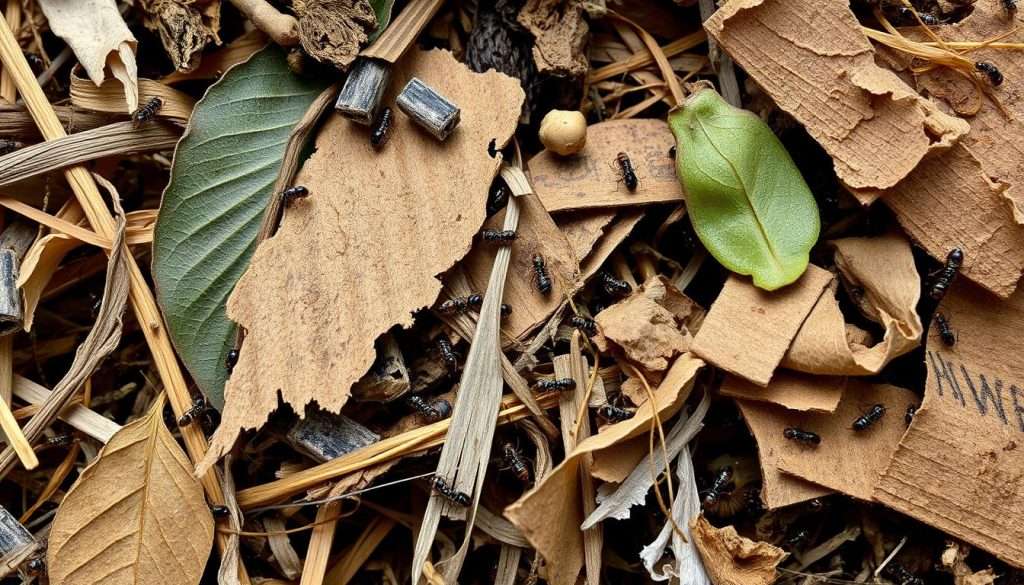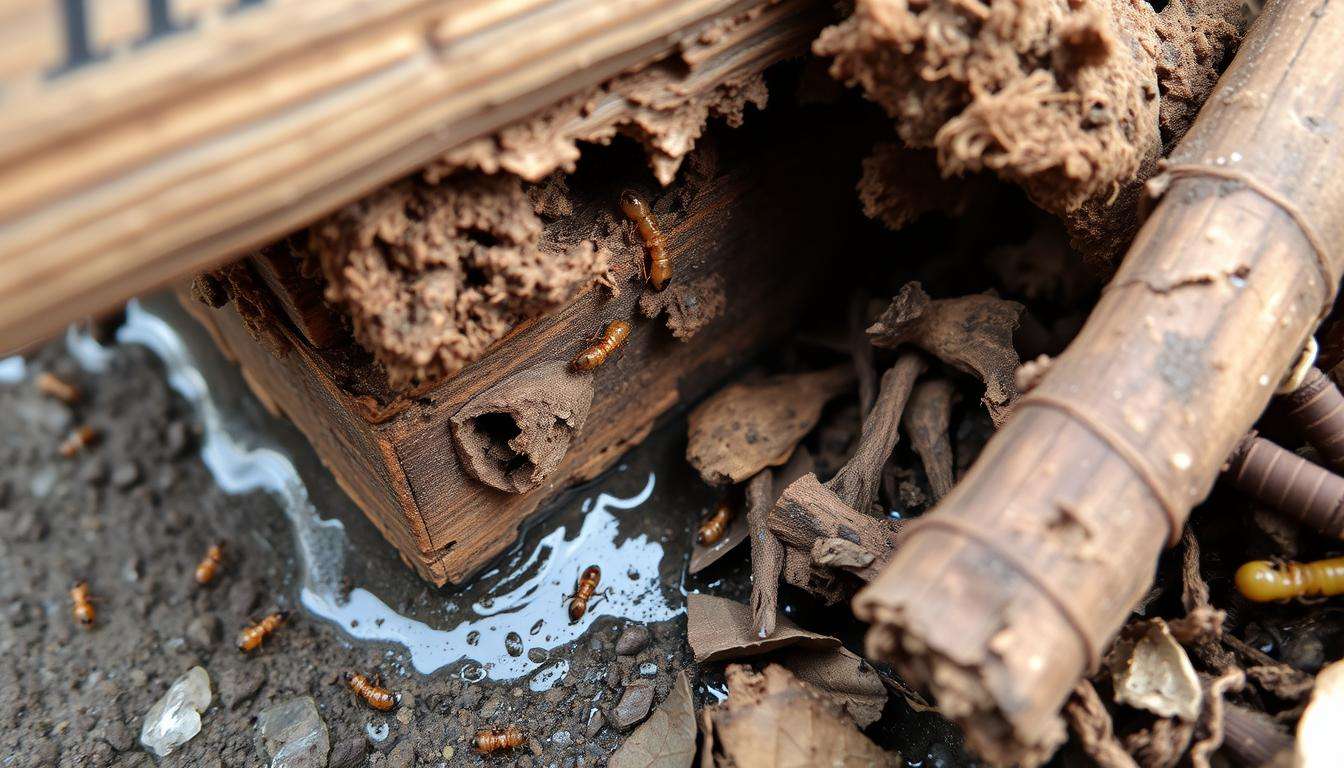Knowing what causes termites is key for homeowners. These insects can cause a lot of damage if not stopped. They are drawn to moisture, which they find in your home.
At first, you might not see the signs. But finding them early is important for stopping termites. Look for hollow wood, doors that don’t fit right, or mud tubes. By watching for these signs, you can keep your home safe from termites.
Key Takeaways
- Moisture is a leading cause of termite colonies forming in homes.
- Common signs of infestation include hollow wood and mud tubes.
- Early detection and prompt action can prevent significant damage.
- Subterranean termites require contact with soil or wood to enter homes.
- Properly managing moisture and structural vulnerabilities can deter termites.
- Regular inspections are crucial to effective termite prevention.
Understanding Termites: Types and Behavior
Termites are important in our ecosystems. They help break down cellulose materials. But, different types of termites can be a big problem when they get into homes. Knowing about these insects helps us prevent them better.
Common Types of Termites
There are three main types of termites: subterranean, drywood, and dampwood. Each type lives and eats in its own way:
- Subterranean Termites: These termites live underground. They build big colonies in the soil and use mud tubes to get to wood above. They can have millions of members, making them a big threat to homes.
- Drywood Termites: These termites live in the wood they eat. They can be found in walls and roofs. In warm places, they can cause a lot of damage and cost a lot to fix.
- Dampwood Termites: These termites like damp or decaying wood. They are common in coastal areas. They can cause a lot of damage to buildings.
Behavior of Subterranean, Drywood, and Dampwood Termites
Each type of termite behaves differently:
| Termite Type | Colony Structure | Habitat | Feeding Preferences |
|---|---|---|---|
| Subterranean Termites | Large colonies (up to 2 million members) | Primarily soil | Wood, landscaping timbers, and decaying plant matter |
| Drywood Termites | Smaller colonies (often hundreds to thousands) | Wooden structures, roofing materials | Sound wood, preferring drier areas |
| Dampwood Termites | Variable (depending on moisture availability) | Moist wood, usually near water sources | Damp or decayed wood |
Termites swarm in warmer months to grow and spread. Knowing about these termites helps us stop them from getting into our homes. For more info, check out this resource.
What Causes Termites: The Role of Moisture
Knowing how moisture leads to termites is key to stopping them. Too much moisture is perfect for termites. By finding where moisture comes from, homeowners can fight termites better.
How Moisture Invites Termite Infestation
Moisture is a big draw for termites, especially in wet places. Subterranean termites, the worst in North America, love damp spots. Moisture weakens wood, helps termites nest, and grows fungi that termites like.
Checking moisture levels is a must to prevent termites. Homeowners should use moisture meters to check and fix problems.
Common Sources of Moisture in Homes
Finding and fixing moisture spots can lower termite risks. Regular checks can catch problems early. Here are some common moisture spots:
| Source of Moisture | Potential Risk |
|---|---|
| Plumbing leaks | Creates damp environments attractive to termites |
| Poor drainage and grading | Holds excess water around foundations, encouraging infestations |
| Unsealed wooden structures | Allows moisture accumulation, facilitating termite access |
| High humidity (above 70%) | Ideal conditions for termite activity |
| Landscaping issues (e.g., trees near foundations) | Traps moisture, creating conducive environments for nesting |

By tackling these moisture sources early, homeowners can lower termite risks. This keeps their homes safe and strong.
Structural Vulnerabilities that Attract Termites
It’s important to know how termites find their way into homes. They can sneak in through tiny openings. Cracks and gaps in foundations and wood touching soil are big attractants. Fixing these problems can help protect your home from damage.
Cracks and Gaps in Home Foundations
Even tiny cracks in your foundation can let termites in. These small openings might not be noticed until it’s too late. Here’s why you should worry:
- Entry Points: Cracks let termites into wooden parts of your home, causing damage over time.
- Moisture Retention: Gaps can hold moisture, making them perfect for termite colonies to grow.
- Inspection Needs: Check your home often to find and fix any foundation problems early.
Wood in Contact with Soil
Termites need moisture and wood to survive. Wood touching soil is especially risky. Here’s what you need to know:
- Direct Access: Wood near the ground is easy for termites to get to, leading to damage.
- Moisture Sources: Bad drainage and moist soil near your home can draw termites in.
- Preventive Efforts: Keep wood away from soil. Check and change your landscaping to avoid moisture problems.
The Importance of Geographic Location
Knowing about geographic location helps us understand termite activity better. Homeowners should know that certain environmental conditions can lead to infestations. Warm, humid climates are especially good for termites.
Why Warm and Humid Regions are Prone to Termite Infestations
Warm and humid areas are perfect for most termite species. This is because of:
- Temperatures above 70°F, which help termites grow and reproduce fast.
- High moisture levels, which are great for termites to thrive and spread.
- Wood and other cellulose materials, making homes in these areas more at risk.
With about 28 invasive termite species worldwide, it’s clear we need to act fast in these climates.
Impact of Local Climate on Termite Behavior
The local climate really changes how termites behave. Places with:
- Regular rain tend to have more termites, as moisture helps them build nests.
- Seasonal changes can slow down or stop termites from reproducing.
- Very hot or cold temperatures might kill some termites, but many can survive different conditions.
With more areas becoming termite-friendly by 2050, it’s crucial for homeowners to be ready. Using local-specific strategies can help keep your home safe.
Signs of Termite Infestation
It’s important for homeowners to know the signs of termites. Spotting these physical indicators of infestation early can prevent big damage and expensive fixes. We’ll cover common signs of termite activity to help you act fast if needed.
Identifying Common Physical Indicators
Termites can damage homes without being seen. They can cause a lot of harm before anyone notices. Here are some common signs of termites to watch for:
- Mud tubes on exterior walls—these tubes protect termites as they travel to and from their food source.
- Hollow-sounding wood—wood that sounds empty may indicate a termite infestation.
- Frass (termite droppings)—findings that resemble pellets may appear near affected areas.
- Buckling floors or walls—structural damage may cause visible sagging.
- Small holes in drywall and discolored or drooping drywall.
- Squeaky floorboards or stuck windows and doors due to wooden support issues.
- Mud accumulation in areas that may previously appear clean.
- Shedding wings left behind after a swarming event, typically occurring twice a year.
- Maze-like patterns in furniture due to feeding activity.
What to Look for in Your Home
Regularly check your home for signs of termites. Look for the physical indicators of infestation mentioned. Focus on moist areas and where wood meets the ground, as termites love these spots.
To keep your home safe, do the following:
- Check your basement and crawl spaces for mud tubes and wood damage.
- Look under your sinks and around plumbing for any water leaks that create moisture conducive to termite activity.
- Examine wooden structures both inside and outside your home for hollow sounds and droppings.
For more detailed info on detection, check out professional resources on signs of termite infestation.
What Causes Termites: The Role of Cellulose Diet
Termites love to eat wood and plant materials. They have different tastes, which helps us know where they might go. Knowing this can help us stop them before they start.
Understanding Termites’ Dietary Preferences
Termites eat a lot of things, like:
- Wood
- Plants
- Carpet
- Insulation
- Cardboard
- Sheetrock paper
- Fabric
- Animal feces
They have special helpers in their stomachs. These helpers break down wood into sugar. This way, termites can share food with each other and stay alive.
Types of Wood that Attract Different Termite Species
Knowing what wood termites like helps us fight them better. Here’s a list of termites and their favorite woods:
| Termite Species | Preferred Wood Type | Additional Notes |
|---|---|---|
| Subterranean Termites | Any wood, particularly with moisture | Utilize tunnels in soil to reach wood. |
| Drywood Termites | Dry wood like furniture and attic framing | Rarely need soil contact, can be transported via infested wood. |
| Dampwood Termites | Moist, decaying wood | Commonly found in dead trees and logs. |
| Formosan Termites | Variety of wood types, including non-cellulose materials | Exhibit aggressive feeding behavior. |
By knowing what termites eat and like, we can stop them. Keeping wood off the ground and controlling moisture helps a lot.

Effective Termite Prevention Strategies
Keeping your home safe from termites is crucial. By controlling moisture and checking for termites often, you can lower the risk of damage. Here, we’ll look at key steps to protect your home from these pests.
Moisture Control and Source Elimination
Termites love moisture, so controlling it is vital. Start by finding and fixing moisture problems in your home, like:
- Leaky roofs and gutters
- Improper drainage systems
- Too much humidity in basements or crawl spaces
Check your plumbing often and fix leaks. In areas with termites, treat the soil with termiticides. For new homes, use TERM® Underslab Barrier for strong protection.
Regular Inspections and Maintenance Tips
Get your home checked for termites every year, especially in termite-prone areas. Trained experts can find problems early. Important parts of these checks include:
- Looking at the foundation and entry points for holes
- Checking wood for damage, like hollow sounds
- Watching moisture levels in risky areas
Keep your yard clean and wood away from soil to prevent termites. Stay away from your home’s foundation with landscaping. Working with pest control pros, like Stomp Pest Control, can give you extra peace of mind.
| Termite Prevention Strategy | Description | Benefits |
|---|---|---|
| Moisture Control | Eliminating excess moisture sources to deter termite attraction. | Reduces infestation risks significantly. |
| Regular Inspections | Annual checks for signs of infestation or damage. | Ensures early detection and prevention of severe damage. |
| Soil Treatments | Applying termiticides to create barriers before construction or during inspections. | Protects foundations and structures from subterranean access. |
| Building Material Choices | Using termite-resistant materials in construction. | Minimizes risk of infestation over time. |
Using these strategies shows you’re proactive in protecting your home. Manage moisture, schedule inspections, and use pest control to keep termites away. Start now to keep your home safe and secure.
Conclusion
Knowing what causes termites is key to keeping your home safe. Spotting signs of infestation and understanding what attracts termites helps a lot. Termites can damage your home a lot, especially subterranean ones.
Moisture, site care, and regular checks are vital for termite control. Keeping your home dry and away from wood is important. If you see signs of termites, get help fast to keep your home safe.
Keeping wood away from soil, good air flow, and using barriers help a lot. By following these steps, you can lower termite risks. This way, you can keep your home safe and free from pests.
